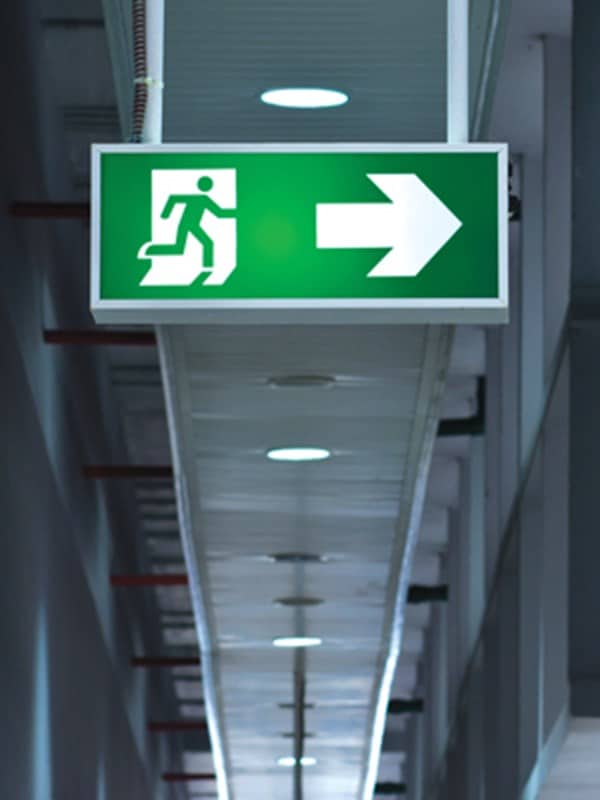There is nothing more important than safety in your home or workplace, yet it’s easy to take for granted. It goes without saying that the impacts of a fire can be absolutely devastating, so it’s natural to want to protect ourselves and our possessions that we’ve worked hard for. It’s not only human instinct, it’s the Law for businesses and landlords to put relevant fire safety measures in place.
If you’re currently exploring different fire protection services for your business, it’s likely that you’ve already come across the terms active and passive fire protection during your research.
This article will explain the difference between active and passive fire protection and give you an overview of the various fire protection services offered by FireRite.
FireRite has expertise covering a wide range of fire safety services to clients across Wales and the South West area who are looking for active and passive fire protection solutions.
FireRite has expertise covering a wide range of fire safety services to clients across Wales and the South West area who are looking for active and passive fire protection solutions.
What is the difference between active and passive fire protection?
In basic terms, Active fire protection is about detecting, stopping and escaping fire. Whereas passive fire protection means containing the fire and preventing it from spreading further.
You need both an active and passive fire safety system working together to prevent, detect and alert, restrict and potentially suppress a developing fire. It’s not a case of active fire protection being more effective than passive fire protection or vice versa. Both systems work simultaneously and in tandem with each other.
Let’s have a look at what this all means in more detail…
A closer look at active fire protection
Active fire protection requires action to be taken to detect and alert, stop or contain a fire. This may involve a person taking a manual action, such as using a portable fire extinguisher. On the other hand, this may be a smoke detector that triggers an alarm or automatic sprinkler. Automated or digital systems are also considered active forms of fire protection.
Products that come under active fire protection include:
Fire alarm systems – well-maintained alarm systems are designed to detect fires early and allow occupants time to evacuate.
Emergency escape lighting – for use in the event of power failure, this should be trigged automatically.
Fire suppression and sprinkler systems – devices containing either CO2, inert gases, foam or water mist.
Smoke ventilation, including automatic vents – allows smoke to escape from a building whilst keeping corridors and stairwells smoke-free.
Disabled refuge areas – essential for assisting disabled people or people with impaired mobility to evacuate in the event of an emergency.
Fire hydrant testing and maintenance – used by Local Fire and Rescue Services to access water from the underground mains supply.
Emergency voice communication systems (EVCS) – a bidirectional, secure duplex voice communication system to assist the fire service in high-rise or large buildings.
Dry and wet risers – valves and pipework to enable the fire service to pump water on to specific floors of multi-story buildings.
Public address voice alarms – often known as a ‘Tannoy’ or PA system, used to provide pre-recorded messages during an evacuation or in the event of an emergency.
Fire hose reels – used by trained individuals or the fire service to contain fires, they require a specific flow rate and water pressure.
Portable fire extinguishers – there are various types of fire extinguishers for use on different types of fires. Training is required in order to learn how to use fire extinguishers properly.
Learn more about FireRite’s active fire protection services.
A closer look at passive fire protection
The objective of passive fire protection is to prevent the spread of a fire throughout a building. Passive fire protection doesn’t necessarily require intervention in the event of a fire, but it does need to be correctly installed and used properly.
Passive fire protection is a vital element of the building’s fire safety strategy. Its role is paramount in safeguarding people, as well as limiting damage to buildings and their contents from fire and smoke.
Despite its name – passive fire protection does not mean that you can set it up and forget about it! Regular testing and ongoing maintenance are still equally important.
There are several products that are considered passive fire protection that can be incorporated into your fire strategy. Here are some examples:
Fire Doors – an internal fire door can slow fire or smoke from spreading throughout a building, allowing more time for evacuation.
Compartmentation and fire stopping – ensures that walls, floors and ceilings are have continuous fire resistance to assist with restricting the size and spread of a fire.
Fire Curtains - secure, unobtrusive and cost-effective alternative to fire doors that can help prevent a fire from spreading.
Fire and smoke dampers – installed where ducts from the heating, ventilation or air conditioning system passes through walls or floors and can help prevent the spread of a fire, although these may be activated by an active system e.g. a fire and smoke damper linked to the main fire alarm system.
Learn more about FireRite’s passive fire protection services.
Installation of Fire Protection Systems
It is crucial that only certified, professionally trained engineers install these devices. Also, fire safety should never be added as an afterthought. Effective fire safety should be at the centre of any new building projects.
If you’re not sure what you need for your building or business premises, the Firerite team has extensive knowledge of delivering fire consulting services and risk assessments across a variety of sectors and buildings. Our cost-effective, professional service meets current legislative requirements.
Our team can design and install any fire protection systems to ensure people and property are protected.
Get in touch with us today to discuss your requirements.
Fire Protection System Maintenance
Many of the fire protection products discussed in this article do require regular and ongoing maintenance in order for them to be fully effective.
For example, fire alarms should be routinely tested and frequently monitored, staff and occupants of a building should receive training on how to use portable fire extinguishers, and fire doors should be routinely inspected and maintained to ensure they remain fit for purpose.
The last thing you need is for your system to fail at a crucial time, so keeping your fire protection systems well-maintained is important for your own peace of mind too.
It is important to remember that a poorly maintained fire safety system or device is about as useful as having no protection at all.
So, whether you need pre-planned, routine maintenance and monitoring or you need an emergency repair at short notice, we’re here to support you. FireRite have highly experienced in-house engineers, dedicated support staff and free technical help. Our engineers are friendly, knowledgeable and trained on a wide range of life safety systems.
Get in touch with us today to discuss your requirements.
Active vs Passive Fire Protection: Summary
To summarise…
- Both active and passive fire protection methods are crucial for protecting your premises, staff, visitors, and business assets.
- Active and passive fire protection systems play different roles but ultimately work together to prevent and contain fires, as well as assist the emergency services when necessary.
- Correct installation and maintenance of all fire safety systems is extremely important and should be performed regularly by certified experts.
- The fire safety consultancy team at Firerite is made up of highly experienced and skilled individuals who can help with all aspects of fire safety at your premises.
Remember, your fire risk assessment is the process of identifying fire hazards and evaluating the risks to people arising from them, taking into account the adequacy of existing fire precautions (including passive and active measures), and deciding whether or not the fire risk is acceptable. The person who carries this out and documents the significant findings of your fire risk assessment is expected to be competent suitably qualified person.
Learn more about fire risk and compliance.



